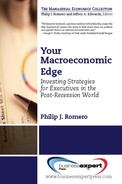To the Reader: Why This Book?
The final few years of the decade of the 2000s demonstrated, with a vengeance, how economic forces can wreak havoc with our daily lives. A brave few used their economic literacy to recognize and take advantage of this once-in-a-decade opportunity to get rich. Whether you wish to get ahead, or only to keep your head above water, understanding the economy is no longer optional.
Unfortunately, most economics courses are long on theory and short on practical applications. It is usually left up to the student to identify real-world examples of the abstract concepts they encounter in textbooks. Busy executives, balancing work responsibilities with the demands of executive education, have little patience with the purely theoretical. Real examples can reinforce learning through illustration, making it relevant. Although many textbooks try to do this, the volume of material they must cover leaves little room for extended illustrations, and those few that are included typically have a strong “toy example” flavor. This book fills that gap.
This volume is a companion to a traditional economics text. It focuses on two applications of economics: (a) for individual investors and (b) for corporate developers (e.g., strategy and M&A specialists). The emphasis in most of the chapters is on individual investing, because all of us will be investors, so we can accumulate the assets we need to retire someday. But significant corporate implications are also addressed in the final chapter.
The core premise of this book is that an executive’s knowledge of economics can allow her to identify, and act on, threats and opportunities before competitors do. These competitors may be other firms in your industry, or other investors (individuals or institutions) who may bid up (or down) the price of an asset you wish to acquire or to sell. The need to track broad outside forces that can affect the environment within which you compete will come as no great surprise to you, but the utility of economics to do so may.
The majority of this book is a discussion of two great long-standing and interrelated forces affecting the developed world’s economies—the fiscal tsunami of government financial profligacy and the demographics of declining birth rates—because they will shape our economic and business environment for decades to come. It presents these forces, and their implications, in a series of short chapters. Each concludes with a brief summary. Those pressed for time may wish to scan the summaries first and dive deeper into those chapters most pertinent to their interests.
This book was written in the midst of the Great Recession in 2009 and early 2010, based on research and thinking of a few years earlier, in 2005 to 2008. Because events in the world economy unfold quickly, some small details are now dated. (For example, the 2007–2009 recession has now officially been declared over, although the economy has been gaining altitude quite slowly, as this book predicted.) But since the book concentrates on long-term trends that will unfold over decades, any obsolete items are quite minor. I am often asked how well my predictions made in the mid- and late 2000s had stood up to the events of 2010 and 2011. The greatest surprise was the speed at which my forecast became reality.
While most of the book is an extended case study of the environment investors will face over the next 10 to 20 years (and is particularly relevant to anyone with a long investing time horizon), the penultimate chapter outlines how economics can be used in corporate strategy decisions, with emphasis on corporate development such as M&A and divestitures. I’ve attempted to use as little jargon as possible, and no graphs. I assume no prior economics education, although you may well find that your worldly experience has informed you about the economy more than you had realized.
Several appendices provide background. One is a primer on long-term investing (emphasizing investing for retirement) for beginners. Another is an introduction to international economic forces that can shape the market for assets. Suggestions for further reading are available in a resources appendix. Finally, a guide to relevant business school case studies related to each chapter is included for instructors who use case teaching methods.
The economic world evolves continuously, so new information will be added at my website: http://lcb.uoregon.edu/forms/profile/profile.html?id=362&format=full. Check it out for news and commentary on themes explored in the book and on the evolving world economy.
May your continuing economic education be rewarding, in every sense of the word.
Philip J. Romero
Beaverton, Oregon
August 2010
